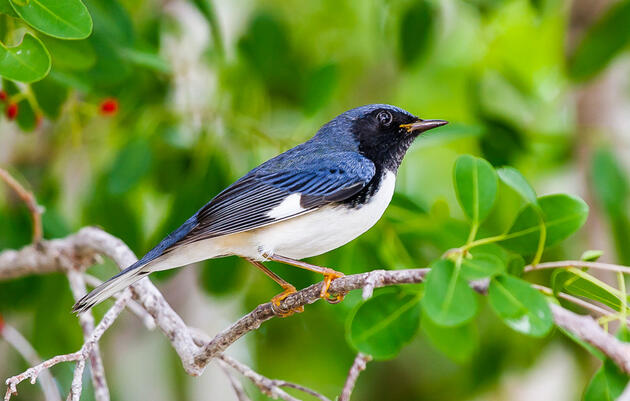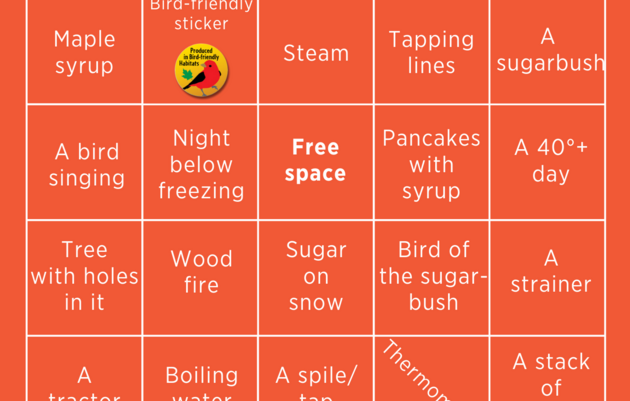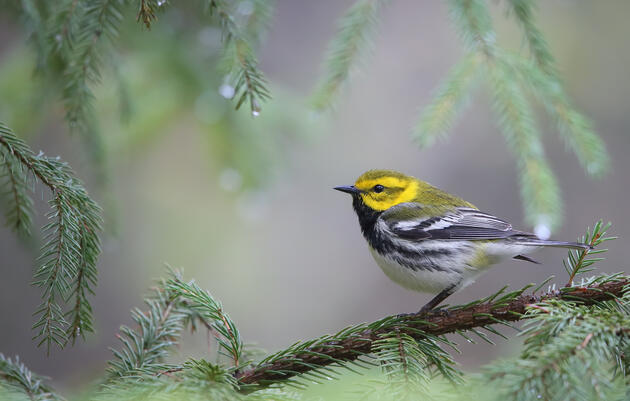About the author: Alexander is a citizen of the Nulhegan Band of the Coosuk Abenaki Nation whose passion for maple sugaring is rooted in Vermont's Northeast Kingdom where he assisted his parents and older sisters to collect and boil down maple syrup. He is a recent graduate of Dartmouth College where he studied Environmental Studies with a focus in Native American Studies. He is particularly interested in the different ways in which communities relate to and depend upon natural resources, an interest which developed during time spent fishing and hunting with his grandfather, as well as working with dairy farmers across the northern part of the state for the U.S.D.A. 's Natural Resources Conservation Service.
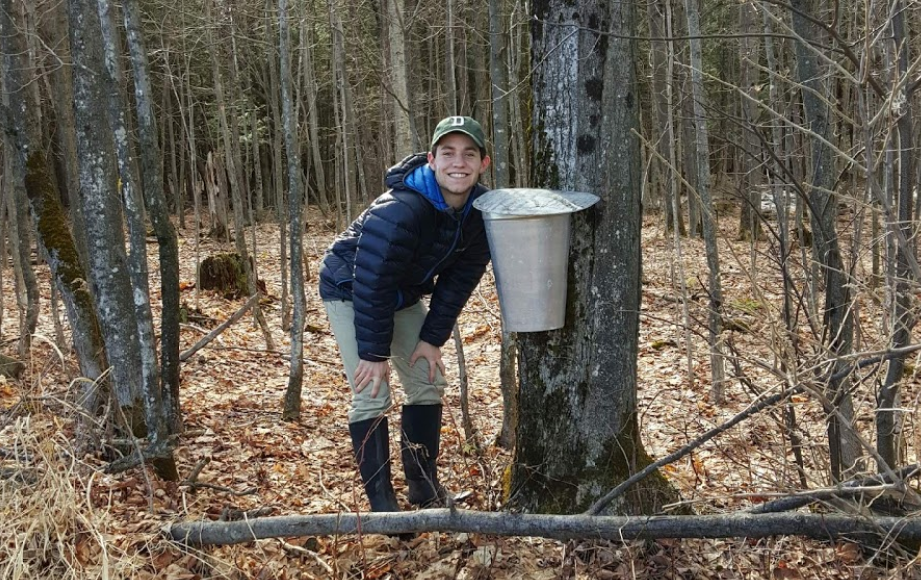
As spring temperatures begin to climb across Vermont’s forested landscape, the annual arrival of “sugaring season” - that time of year when families, farmers, and maple producers gather to tap sugar maple trees and boil down the resulting sap into maple syrup and maple sugar - will soon be underway. Today maple sugaring seems to be everywhere you look in Vermont; in fact it’s nearly inescapable. As Steve Wheeler, owner of Jed’s Maple Products in Newport, VT recently noted over the phone “It’s almost as if maple sap flows through Vermonter’s veins like it does through the branches of the trees in our woods… it’s a part of us.” Indeed, maple syrup has deep roots in both Vermont’s cultural heritage and economy, and the state’s maple industry has continuously grown since the 1970s. In 2020, Vermont recorded it’s highest maple production yet - producing over 2.2 million gallons of the so-called “liquid gold” - representing over half the official crop of the United States and by far the most of any state. Part of Vermont’s increased production was due in part to a record number of taps across the state - over 6,150,000 in total - as sugaring has grown in popularity among hobbyists and commercial operations alike.
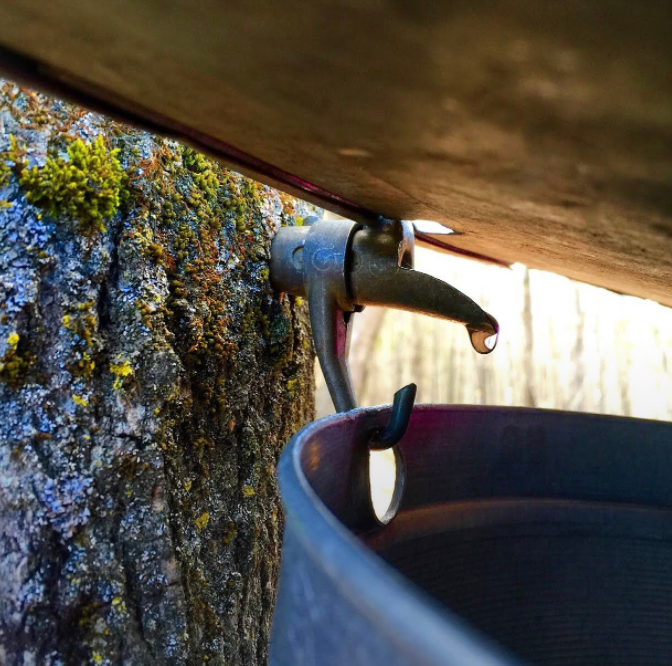
When you ask anyone who doesn’t live in Vermont what they know about the state, chances are maple syrup is one of the main images that comes to their mind, alongside dairy farming and our iconic Green Mountains. The process of tapping, collecting, and boiling sap from wild-growing stands of sugar maple trees into sweet treats has become an annual ritual for families, providing a time to gather, celebrate the arrival of spring, and gain sustenance from the land in the process. In fact, quality maple syrup seems to have become synonymous with the “Vermonter” identity today. Don’t love eating maple syrup on pancakes or a good maple balsamic dressing over your salads? Well, your tastes might cause others to doubt whether you are a Vermonter to the core. All jokes aside, quality maple syrup and romanticized images of maple production have become ingrained in the minds of those who think of Vermont, largely thanks to a combination of the prevalence of sugaring across the state, storytelling and maple advertising. Whether we’ve visited sugarhouses during elementary school field trips, our neighbors or family members make syrup, or we’ve purchased maple products at the store - many of us are familiar, or think we are familiar with the history of this beloved agricultural practice and what a traditional “sugar maker” looks like. Unfortunately, most of us don’t know the history of Vermont maple prior to the 1800-1900s, which means we’re leaving out a potentially large portion of maple’s history.
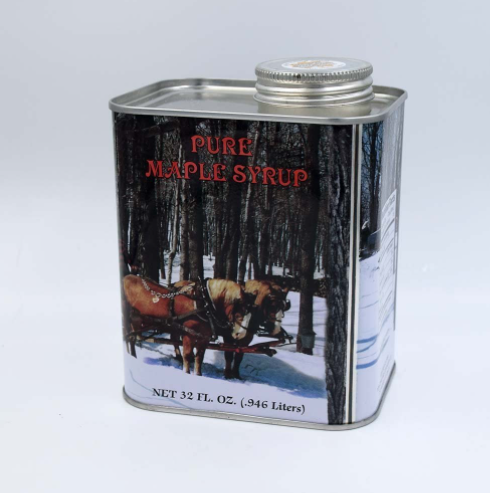
Now, I encourage you to stop reading this article for a moment and imagine the depictions of maple sugaring you’ve encountered - perhaps you can visualize log cabins painted across the walls of Vermont gift shops, or those adorning maple syrup jugs at your local grocery store. Depictions of Vermont maple sugaring usually follow the same central colonial narrative - a pastoral woodland scene with (usually) white, male farmers wearing red plaid jackets collecting sap from tin buckets, often with a horse and sled in tow. These images have become synonymous with the “brand” that has become Vermont maple syrup that even if you are a diehard maple fanatic, you’ve likely never noticed what these “traditional” sugaring scenes are lacking - Vermont’s Indigenous Abenaki peoples who first perfected, and then passed their maple sugaring knowledge on to European colonists.
On this note, I’d like to spend some time today highlighting the Abenaki history of maple syrup; a story which I believe is both misunderstood and undertold, yet crucial to painting a more realistic narrative of the origins of maple production in the region. The Abenaki (also called the Abnaki, Abinaki, or Alnôbak depending on where you are located) are a group of Native American Algonquian-speaking peoples that lived- and continue to reside - in a region called Wabanahkik (pronounced “wah-bah-NAH-keek” - this translates to "the land of the dawn"), a territory now encompassing parts of Quebec and the Maritimes of Canada as well as northern sections of New England including Vermont, New Hampshire, and upstate New York. Although the history of Abenaki peoples is a complex one (I don’t have sufficient space to go into detail here) - like many Indigenous communities, Abenaki communities faced many challenges following the arrival of French missionaries and later English colonists in the Northeast, including entanglements in geopolitical disputes between the French and English colonists, introduced diseases, land dispossession, and even eugenics projects implemented in Vermont targeting disabled and Indigenous people through coerced sterilization, a practice which plateaued around World War II and lasted until as recently as the 1970s according to historian Nancy Gallagher, author of Breeding Better Vermonters: The Eugenics Project in the Green Mountain State. Despite relocation and widespread violence perpetrated against Abenaki peoples, today four state-recognized tribes exist, including the Elnu Abenaki Tribe, the Koasek Abenaki Tribe, the Missisquoi Abenaki Tribe, and the Nulhegan Band of the Coosuk Abenaki Nation (my family belongs to the latter).
Maple sugaring had been practiced by many Indigenous communities across North America before the arrival of Europeans, including the Abenaki people of Vermont, who have resided in the northeast since the glaciers receded an estimated 11,000 - 10,000 years ago at the end of the last Ice Age. Long before the arrival of European explorers and French missionaries, Abenaki peoples followed a multi-step process for collecting and condensing sugar maple sap into sweeteners; a process refined and passed down orally from one generation to the next. One of the first written accounts of the Abenaki sugar-making process comes from Jesuit Sebastien Rasle, who wrote on October 15, 1722 while living among the Kennebec Abenaki “... There is no lack of sugar in these forests. In the spring the maple-trees contain a fluid resembling that which the canes of the islands contain. The women busy themselves in receiving it in vessels of bark, which it trickles from these trees; they boil it, and obtain from it a fairly good sugar” (Travels and Explorations of the Jesuit Missionaries in New France. 1610- 1791., pg. 95). As this quote indicates - Abenaki women, more often than men - were heavily involved in the sugaring process, as they were with many food gathering practices. According to anthropologist Matthew M. Thomas, author of over a dozen books and peer-reviewed articles about the history of maple sugaring, including: The Archaeology of Great Lakes Native American Maple Sugar Production in the Reservation Era (2001) and A 1952 Visit to an Indian Sugarbush (2003) one of the main ways Indigenous sugar making differed from European systems was that “traditionally, Native American women were the leaders of the operation… they ran the sugarbushes, made and repaired the baskets, and boiled the sap. Women were the primary sugar-makers.” Unlike traditional European sugaring operations where men were delegated most - if not all - of the tree-tapping and sap-gathering tasks, Native women were front and center during the sugaring season in Indigenous communities.
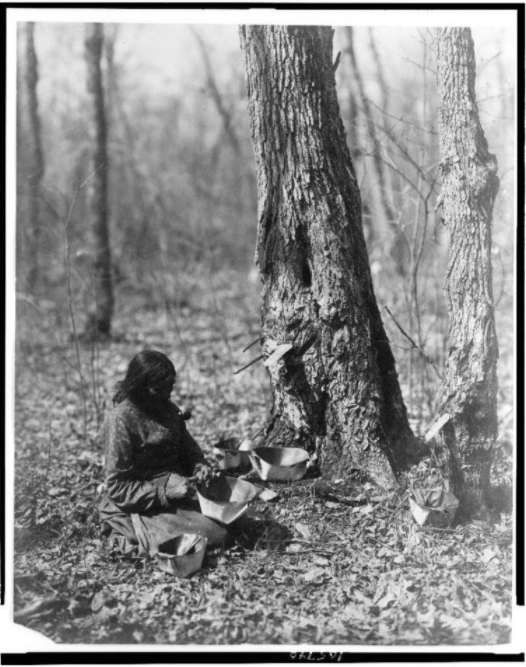
In traditional Abenaki sugaring, maples were tapped by cutting a diagonal notch in the bark and then a flat spile made of cedar or slippery elm was inserted just below the bark layer. (In later years, spiles were constructed of hollowed salonakwam (sumac twigs) hammered into a hole cut in the bark). The sap would then drip down the wood spile into clay or woven birch-bark sap baskets - called maskwaijo - placed at the foot of the trees. Next, in order to reduce the amount of water in the sap prior to boiling, the container was left to freeze and the ice forming on top of the maskwaijo was discarded (think of this as a natural version of today’s reverse osmosis machines, which instead use a semipermeable membrane to remove dissolved sugar particles from the water prior to the sap entering the evaporator pan).
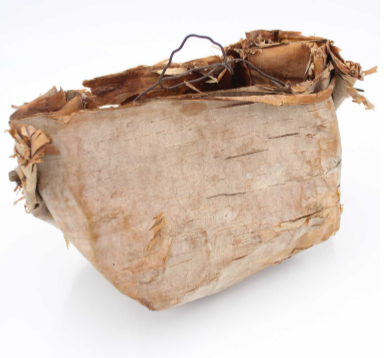
After being poured into large carrying buckets or transported by odahôgan (a sled/toboggan) to the fire, the sap was either poured into clay pots placed among the coals or suspended above the flame in order to boil. Contrary to popular belief, Abenaki sugar-makers - at least those producing maple sugar for a family or larger group - would not have placed heated stones into a hollowed-out log containing the sap to produce maple syrup and sugar. Caleb Musgrave, an outdoor educator and Anishinaabe man from Hiawatha First Nation in Ontario has explored this hypothesis through experimenting with hot rocks and has demonstrated time and again (alongside a growing amount of evidence from archaeologists and anthropologists) that the process would have added so much ash to the sap that it would make the resulting foodstuffs inedible. Besides, as archaeologists will support, many Indigenous communities of the Northeast - including the Abenaki, Algonquin, Iroquois, Penobscot, Penacook, Mi'kmaq, Wampanoag, and Mohawk, among many others - used clay or soapstone pots to boil soups and herbal medicines long before the arrival of European colonists, contrary to modern legends. These same pots could be used for boiling down sap. As Brian Chenevert, Tribal Historian for the Nulhegan Abenaki Tribe recently recounted, “It’s quite silly, and somewhat egotistical to think that Native peoples were unable to develop cookware to boil over a fire until the arrival of Europeans… I think it’s important to understand that this wasn’t the case.”
Similar to how today’s evaporator pans have multiple sections designed to separate the various stages of sap as it thickens on its way to becoming syrup, multiple pots were employed for the various stages of the sap reduction process, with the contents of one pot being poured into the other. To produce granulated maple sugar, once the sap had been boiled down until it was quite thick, it was poured into a basswood or walnut trough, then stirred with a wooden paddle to continue the evaporation process. Because storing maple syrup - or mkwakbaga (red water) as we call it - was more difficult than storing maple sugar, historically any mkwakbaga that was made was eaten relatively soon after the harvest. Contrary to most sugaring operations today, the majority of sap was instead used to make granulated maple sugar, which was in turn used to season meats - including venison and squirrel - as well as fruits and vegetables. Maple was also used as an additive in herbal medicines to make them more palatable.
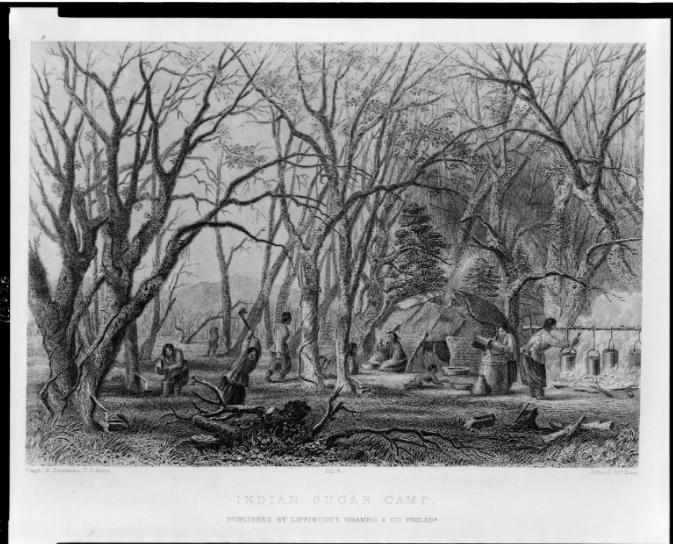
Aside from it’s culinary and medicinal uses, the importance of maple to Abenaki peoples is also evidenced by our language and our traditional stories. In addition to having specific words like “mskwajo” to distinguish birch bark baskets used for gathering sap from other, more ornate birch-bark baskets, we also have specific words in Western Abenaki, our traditional language, for the process of gathering maple sap, which we refer to as pkwamha. The way we conceptualize the passage of time is also influenced by the annual maple harvest and reflected in the words that we use to describe spring. For example, the period of time Europeans call the end of March- April is known as Sogalikas (pronounced “sew-gal-EE-kas”) in Abenaki culture, which literally translates to “time of maple sugar making.” Aside from having roots in our language and our calendars, our traditional stories, which serve to teach us morals and how to interact with the natural world around us, also incorporate maple. One story that comes to mind explains how Gluskabe (other spellings include Kluskap, Glooscap, Koluskap, Gluskap, and Glooskap)- a kind, yet mischievous trickster often featured as a protagonist in Abenaki stories - helped create the diluted maple sap we know today. The story goes as follows (note: as with most oral traditions, the version I’ve been told may differ from other variations of the narrative):
Thousands of years ago, Creator made many gifts that they shared with humans so that we could live full and meaningful lives. Since Creator was very wise, they made sure to provide food to feed the Abenaki people during each of the seasons. First, Creator provided moose and deer for the Abenaki to hunt during the long winter months, then berries and other fruits for picking in the spring and summer. Finally, he led the waterfowl to return during their fall migrations so they could be hunted by canoe before the open water entirely froze over. Among the things they provided, Creator was especially pleased with the sugar maple tree - senomozi - since it’s sap was as thick and sweet as honey. Shortly after Creator made the senomozi alongside the other provisions for the People, Gluskabe travelled as an owl from one village to another to keep watch over all the villages on Creator’s behalf. One day, Gluskabe found a once-thriving village in disrepair… the bean and squash fields had become riddled with weeds, and the fires had all been extinguished. Although he searched far and wide, he couldn’t find the people anywhere in the village. As night descended upon the valley and he sat by the glowing embers of a fire, waiting to see if the people would return from a hunting or gathering party, a strange rumbling and gurgling sound drifted from the hill on the wind. Gluskabe flew through the forest toward the source of the sound, into a stand of maple trees. At the center of the stand, he found all the villagers lying on their backs drinking maple sap - their full stomachs and an abundance of sugar had made them unfit to move or do any work. Gluskabe told them to return to their village to tend to their gardens, their fires, and to care for their lands. But the people did not listen. They were happy to lie on their backs, with their mouths open, guzzling the thick honey-like syrup.
Gluskabe shared this news with Creator, who was troubled to learn that the People no longer appreciated all the other joys of the forest. They were sad to see the People were no longer working together, but preferred to sit alone, drinking sweet sap throughout their days. In order to teach the people a lesson, Creator told Gluskabe to transform into a cold northern wind. As Gluskabe descended over the forests, the cold temperatures he brought with him caused the sap to stop flowing from the trees. Gluskabe then swelled and swelled until he swept over the rivers and the lakes, lifting great amounts of water into the sky. Gluskabe carried this water to all the sugar maples across the forest, and fed each of them until all their sap was diluted nearly 40 times.
The next day, when the People awoke to drink their beloved sap, they noticed it no longer flowed like thick honey. They asked Gluskabe distraughtly “Where did our sugar go?” Gluskabe assured them that the sugar had not disappeared, but that now they would have to work hard and boil the sap to produce the golden liquid they loved so much. Upon hearing this, the people decided that they would spend the rest of their days among the sugar grove, boiling both during the day and all through the night so that they could continually enjoy a steady supply of syrup. However, since Creator was very wise, they foresaw that the People might try to spend all their days admiring only the maple trees. To prevent this, they made the sap stop flowing as soon as the leaves erupted from the maples’ branches. From that day forward, the People could only harvest sap for a few weeks each year. And so it is still to this day; each spring the flow of maple sap reminds the Abenaki people of Gluskabe’s lesson in honoring all of Creator’s gifts and the importance of building a sense of community by working together.
Wliwni Creator for your gifts, and wliwni to our ancestors who have passed on these stories.
From all accounts, it is clear that Europeans observed when and how to tap maple trees during interactions with First Nations peoples - including the Abenaki - who had been sugaring for generations. As French missionary Father Sebastian Rasles wrote in 1689, “It is curious to know that the method of extracting… and making maple sugar, articles of considerable importance to us, has been learned of the aborigines” (Lettres édifiantes et curieuses, Paris 1726). Within the greater context of his writings, Rasles’ comments are steeped in racist views of Indigenous people that were prevalent at the time. He, along with many other missionaries, was incredulous to think that “unsaved and brutish peoples” could perfect such a complex process and share their knowledge with Europeans. Father Rasles’ reaction to Indigenous maple sugar-makers was shared by other colonists, who saw Indigenous sugaring methods as inferior to using metal buckets and eventually taps and other tools. Europeans applauded the “greater efficiency” with which syrup could be produced after adapting methods they learned from Indigenous communities.
Given the dismissive attitudes Europeans held toward Indigenous peoples, it is perhaps ironic that the sugaring process wasn’t always easy for Europeans to learn, as recounted by Stephen Williams, who lived with an Abenaki - Pennacook family in Northeast Vermont following the 1704 Raid of Deerfield during Queen Anne’s War. Of his captivity, Williams wrote about the large quantities of sugar they made that year, as well as how he was reprimanded for spoiling the maple sugar after he neglected to stir it properly: "Whilst I lived here I made about fourscore weight of sugar with the sap of maple trees…. because there was a barrel of sap to boil [my mistress] sent me to the sugar place over night to boil it, so that we might go in the morning. I went and kept a good fire under the kettle, little thinking of its coming to sugar, till it was spoiled for want of stirring" (What Befell Stephen Williams in his Captivity, from The Redeemed Captive Returning to Zion. Northampton, MA: Hopkins, Bridgman and Company, 1853, pg. 7.)
By the mid 1800s, maple production spread among European settlers - particularly among farmers - who replaced birch-bark baskets, wooden spiles, and clay pots with tin buckets, spigots, and eventually metal evaporator pans. Although the sugaring process has evolved by leaps and bounds in the 300 years since Europeans settled on the Eastern Seaboard, the core aspects of the process - from the tapping to the boiling - reflect steps Indigenous sugar makers had been refining over generations.
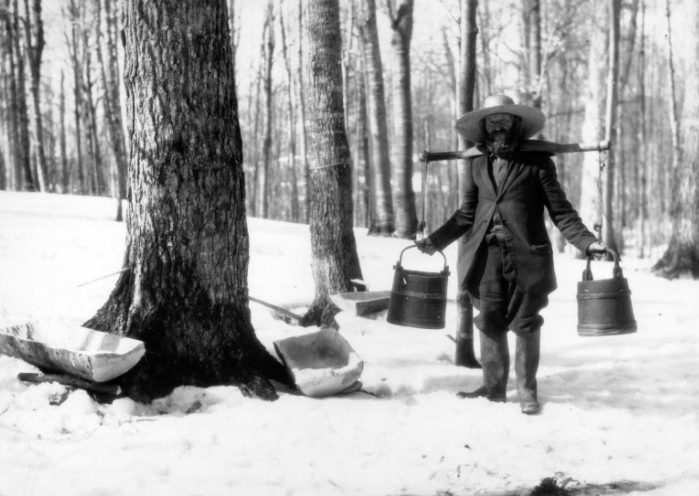
Today, the Nulhegan Abenaki of Vermont (as well as many other Native American and First Nations communities across the U.S. and Canada) keep our sugaring traditions alive by continuing to produce and share maple sugar. At the Nulhegan Abenaki Tribal Forest located in Barton, VT, we produce and bottle maple syrup each spring utilizing modern technologies including an evaporator pan and glass containers for storage. Although the methods have changed, sugaring still functions as a time for our community members to gather and connect with the woods and one another. Through sugaring, we continue to cultivate a working relationship with the land, practice speaking Western Abenaki and we are reminded to give thanks to the woods that have sustained our communities for generations, despite the hardships our ancestors faced.
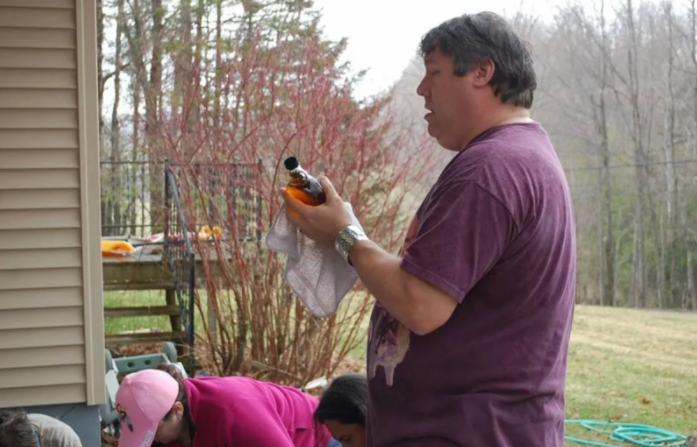
In summation, it is my hope that more Vermonters will come to recognize the ways in which sugar maples, maple foods, and the forests that comprise our sugarbushes are culturally important to Indigenous communities, as well as how the modern practice of maple sugaring was first built from age-old Indigenous traditions. Like a growing number of world-class food products that are finally being recognized as having long cultural histories in the Americas, including maize, potatoes, beans, peppers, tomatoes, pineapples, papayas, chocolate, and vanilla, to name just a few, my hope is that the Abenaki history of maple will be celebrated and shared as a part of the sugaring story in Vermont.
Wliwni (thank you) to Brian Chenevert for sharing your knowledge and extensive research about Abenaki history and the history of maple sugaring with me. I would not have been able to complete this article without your expertise and primary sources you pointed me towards. I would also like to say wliwni to my grandfather - who has shared so many stories and has inspired me to continue exploring my Abenaki heritage. Also, I am grateful for my parents who have taught me how to make maple syrup and have shared their love of the land and food generously with those around them. Finally, I would like to thank Dr. Matthew M. Thomas for sharing his archaeological and historical expertise and passion for maple sugaring with me.
If you are interested in learning more about the Abenaki relationship to the land and how the maple story is alive today in Abenaki-owned sugaring operations, please consider joining a virtual conversation between Chief Don and Vermont Land Trust forester and sugarmaker Caitlin Cusack titled “Traditional Abenaki Sugaring and Stories” which will take place on March, 25th from 7-8pm EST. Chief Don Stevens of the Nulhegan Band of the Coosuk – Abenaki Nation will share the maple syrup story and ancient Abenaki sugaring traditions. You can learn more and register for the event here.
Peer-reviewed books and articles for further reading:
Bruchac, Margaret. "Malian’s Song–Abenaki Language Glossary." Vermont Folklife Center (2006).
Calloway, Colin G. The Western Abenakis of Vermont, 1600-1800: War, Migration, and the Survival of an Indian People. Vol. 197. University of Oklahoma Press, 1994.
Day, Gordon M. "Western Abenaki Dictionary. Volume 1: Abenaki-English. Mercury Series, Canadian Ethnology Service, Paper 128." (1994).
Keller, Robert H. "America's Native Sweet: Chippewa Treaties and the Right to Harvest Maple Sugar." American Indian Quarterly (1989): 117-135.
Manore, Jean L. "The historical erasure of an indigenous identity in the borderlands: The western Abenaki of Vermont, New Hampshire, and Quebec." Journal of Borderlands Studies 26.2 (2011): 179-196.
Nancy L. Gallagher. Breeding Better Vermonters: The Eugenics Project in the Green Mountain State. Revisiting New England: The New Regionalism. Hanover, N.H.: University Press of New England (1999).
Park, Sunmin, Nobuko Hongu, and James W. Daily III. "Native American foods: History, culture, and influence on modern diets." Journal of Ethnic Foods 3.3 (2016): 171-177.
Snow, Dean R. “The Ethnohistoric Baseline of the Eastern Abenaki.” Ethnohistory, vol. 23, no. 3, 1976, pp. 291–306. JSTOR, www.jstor.org/stable/481256.
Turner, Nancy J., and P. von Aderkas. "Sustained by First Nations: European newcomers use of Indigenous plant foods in temperate North America." Acta Societatis Botanicorum Poloniae 81.4 (2012).
Walter, Rosly. "The Wabanakis of Maine and the Maritimes: A Resource Book about Penobscot, Passamaquoddy, Maliseet, Micmac and Abenaki Indians with Extensive with Extensive Lesson Plans for Grades 4 Through 8” (1898)
Wiseman, Frederick Matthew. The voice of the dawn: An autohistory of the Abenaki nation. UPNE (2001).
Resources for Educators:
-
Elnu Abenaki Tribe
Jamaica, VT -
Nulhegan Band of the Coosuk Abenaki Nation
Barton, VT -
Ndakinna Education Center
Greenfield Center, NY -
Decolonizing the History that is Taught in Schools Across the Abenaki Homeland by Vera Longtoe Sheehan
Mt. Kearsarge Indian Museum -
What Is The Status Of The Abenaki Native Americans In Vermont Today?
Vermont Public Radio, November 4, 2016 -
Abenaki Indian Fact Sheet
Native American Facts for Kids -
Native Americans/ Native Vermonters (PDF)
The Vermont Movie
Weternabenaki.com
By: Jesse Bruchac


